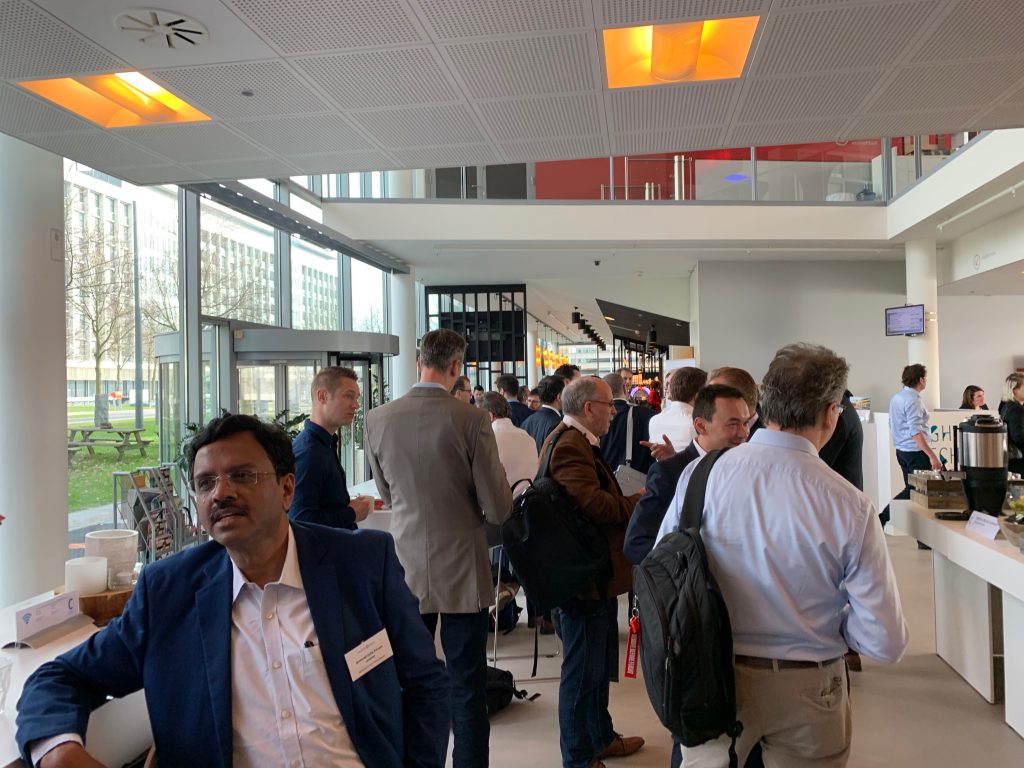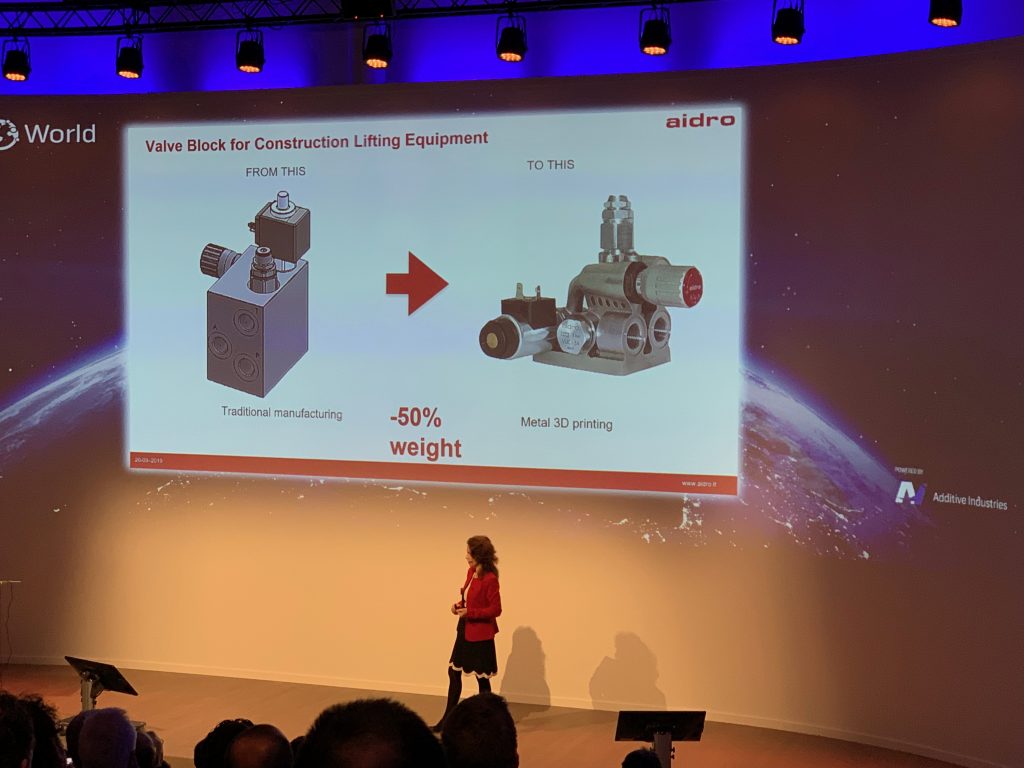Additive World Conference is a great conference in Eindhoven focusing on metal 3D printing. Organized now for the seventh time by metal 3D printer OEM Additive Industries, the summit brings together people interested in metal 3D printing from all over the world. With around 200 participants the show is small scale but the speakers are high caliber coming from the forefront of using metal printing in manufacturing. If you’re a firm interested in industrializing Additive Manufacturing/3D printing, I’d recommend attending this small but high impact conference. The Additive World Conference is now a two-day event with the first day focusing on speakers at a conference center and the second day focusing on a visit to Additive Industries and their manufacturing and R&D facilities.

At the beginning, Additive Industries co-founder and CEO Daan Kersten welcomed us to the event and there was a rather loud and bombastic movie. The first speaker was Manuel Michiels of Materialise and he spoke on Breaking Through the AM Case Barrier with Software Simulations and Automations. Manuel wanted to show how Materialise software is saving firms money in metal 3D printing. The presentation was full of interesting assumptions and calculations that gave a real insight in the cost structure of metal AM. He took us through a detailed cost analysis of EBM. He assumed that if you have a good utilization of 70% of your build volume you could do a 186 builds per year. He also assumed that the software prepping would take 300 minutes and the hardware preparations on the machine would take a 180 minutes. The build itself would take 30 hours and afterwards there would also be another 180 minutes hardware work which would include resurfacing the build plate. He assumed that the initial post-processing steps would cost you thirty minutes for HIP (Hot Isostatic Pressing) and a further 230 minutes to remove the support from parts and remove them from the build platform. He assumed a depreciation over five years for the printer and concluded that labor, the machine, and powder were the highest cost factors. Taking all of this into account he came up with a full build cost of 2322 euros ($2637). This is a great number to input on some spreadsheets to find out if 3D printing could make sense for your business case. The yearly costs were estimated to be 431,384 Euros per year which is much higher than some previously published operating cost numbers but in my mind a more realistic number. I would say that they didn’t take into account further processing such as tumbling and other surfacing steps but since these can vary enormously per part and application I understand why they didn’t include it.
He then went on to talk about how time on the machine is “holy” and all you can do to optimize parts and workflows will save you later on in the process. Some results that he could share was that selected customers had a 90% decrease in total data preparation time and a 20% decrease in powder consumption. He also disclosed that support failure in the number one issue that causes scrappage in 3D printed parts. Indeed a lot of builds fail due to support strategies. Recoater collision, also called recoater bump, was the next biggest cause of machine failure. This occurs when the recoater spreading out material hits the part and damages it. We mention and show you how to optimize to reduce that in in your metal 3D printing builds here. The third biggest cause was shrinklines in the part. He assumed that a varied production line may have a scrap rate of 15% which would mean an annual cost of 50,000 per machine. They managed to reduce this to 7.5% in select customers. We must point out that 15% is very high and one would not expect such a number in a setting where a firm is producing millions of similar parts. If you’re making millions of bridges and crowns, for example, their similarity would mean significantly lower scrap rate. Materialise itself is focusing very much on the disparate parts of Industry 4.0 the 3D printing software leader wants to connect PLM, distributed manufacturing and machine learning. By tying together 3D printing and existing businesses processes the company surely can help others integrate 3D printing into manufacturing.
Next up was Valeria Tirelli the CEO of Aidro. We mentioned before how Aidro is using 3D printing to make better hydraulics and how the firm made a better manifold for a Jaws of life through 3D printing and how they won last years Additive World Design for Additive Manufacturing Challenge. Aidro is an Italian family-owned firm that has looked at the hydraulics industry in a new light through 3D printing. Valeria mentioned that hydraulics has been the same for decades and showed some advertisements for hydraulics from the forties which looked remarkably similar to hydraulics today. She said that by implementing 3D printing they have been looking at how they generate ideas and products differently. They now focus on problem-solving and how to create “new shapes” that solve problems in completely new ways. “Thanks to new additive design, new shapes are now possible.” This changed the firm’s entire design approach and now “new solutions that seemed impossible are possible.”

One of the biggest impacts for them in hydraulics means that whereas traditionally channels are limited in how they can be designed and made this design area is now expanded. The channels in the parts which guide the flow of the liquids through the part are essential in determining the performance of the hydraulic component. Traditionally hydraulic components had a lot of right-angled components and channels. This meant that there was a reduction in flow and turbulence in the liquid. Flow determines the overall performance of the hydraulic part or manifold. Now with 3D printing, we can get round and curved channels inside of these parts which means that their performance is greatly enhanced. Rather than flow being interrupted by abrupt right angles that create turbulence, smooth channels guide liquids around curves and bends in a much more efficient way. The results are more flow and less turbulence.
In some cases Aidro has increased flow from 30% to 70% for example. The company now has changed its design approach to start with the functionality of a part, then they connect the channels and later make ports and cavities to complete the part. With one example part they were inspired by a pepper to make a part with a 50% weight saving and a 40% improvement to flow. Another manifold was inspired by a fennel to have a weight reduction of 70%. In a heat exchanger, they accomplished a 80% weight saving and reduced the overal part length from 1.5 meters to 20 centimeters. Valeria’s presentation was very exciting and points to a huge impact that 3D printing could have over the production of millions of hydraulic systems.
Dr. Tobias Brune of SMS group was next and he presented on the companies new test atomization plant. SMS’s atomization plant lets them produce their own 3D printing powders. He mentioned that there are over 6500 kinds of steel but that the 3D printing industry only uses very few of these. Their own atomizer lets the firm make and test many different metals and produce them on demand close to their plant. The design and manufacturing of their own atomizer is a huge investment for the German automotive manufacturing firm. It is insane in the cost outlay but indeed the only logical approach if you want to manufacture with 3D printing. With so much of the cost coming from overinflated material prices building an atomization plant will have huge speed and cost advantages in the long run. SMS Group is one of the most interesting firms in 3D printing at the moment. The company is making huge investments in trying to create turn key 3D printing plants for large scale manufacturing. Currently, there simply is no solution for a large company that wants to build a plant to 3D print millions of things. Your solution would be to learn on the job and take years. With SMS an automotive firm could work with them to quickly build or create a manufacturing solution. The firm wants to go further into “equipment as a service” and their Scale$Series turnkey 3D printing plants.
Dr.Kristian Arntz of ACAM Aachen Center for Additive Manufacturing and Fraunhofer IPT spoke about the Fraunhofer center at the University of Twente and how they’re expanding a network of research partners. Professor Ian Gibson of the Deptment of Design Production Management at the University of Twente spoke on the machinability of 3D printed parts and the custom creation of porous structures. With the creation of customized controlled porosity part performance can be enhanced. He made the point that most 3D printing implementation are because you want to either change your product or change your process or both. Additionally one could use 3D printing to “provide agility” by “reconsidering the entire process.” He reiterated that the wrong method would be to buy a printer first but partnering and understanding would a more fruitful approach.
Subscribe to Our Email Newsletter
Stay up-to-date on all the latest news from the 3D printing industry and receive information and offers from third party vendors.
Print Services
Upload your 3D Models and get them printed quickly and efficiently.
You May Also Like
Nikon SLM Solutions Sells SLM 500 to Primary Weapon Systems to Expand Suppressor Production
Primary Weapons Systems (PWS) is a Boise, Idaho-based manufacturer of suppressors, firearms, and related components. A subsidiary of Vigilant Gear and a sister company to aftermarket Glock slide manufacturer Lone...
3DPOD 261: Tooling and Cooling for AM with Jason Murphy, NXC MFG
Jason Murphy´s NXC MFG (Next Chapter Manufacturing) is not a generalist service; instead, the company specializes in making tooling. Using LPBF and binder jet, the company produces some of the...
HP and Firestorm Labs Form Partnership to Use Multi Jet Fusion 3D Printers in Deployable Factories
HP Inc., maker of a range of additive manufacturing (AM) solutions including the Multi Jet Fusion (MJF) ecosystem, has announced a partnership with Firestorm Labs, a developer of containerized, deployable...
3D Printing News Briefs, July 2, 2025: Copper Alloys, Defense Manufacturing, & More
We’re starting off with metals in today’s 3D Printing News Briefs, as Farsoon has unveiled a large-scale AM solution for copper alloys, and Meltio used its wire-laser metal solution to...
































